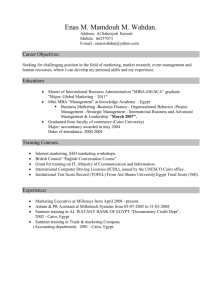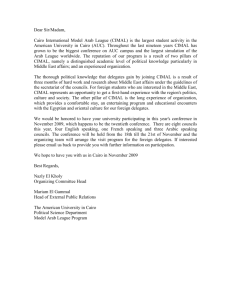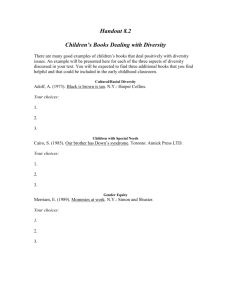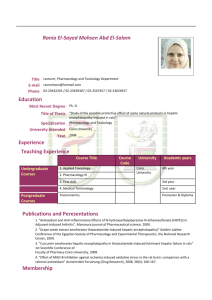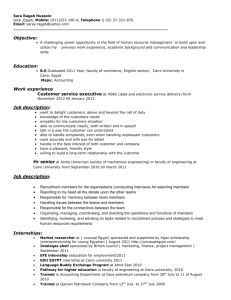Upgrading Downtown Cairo towards friendly mobility
advertisement
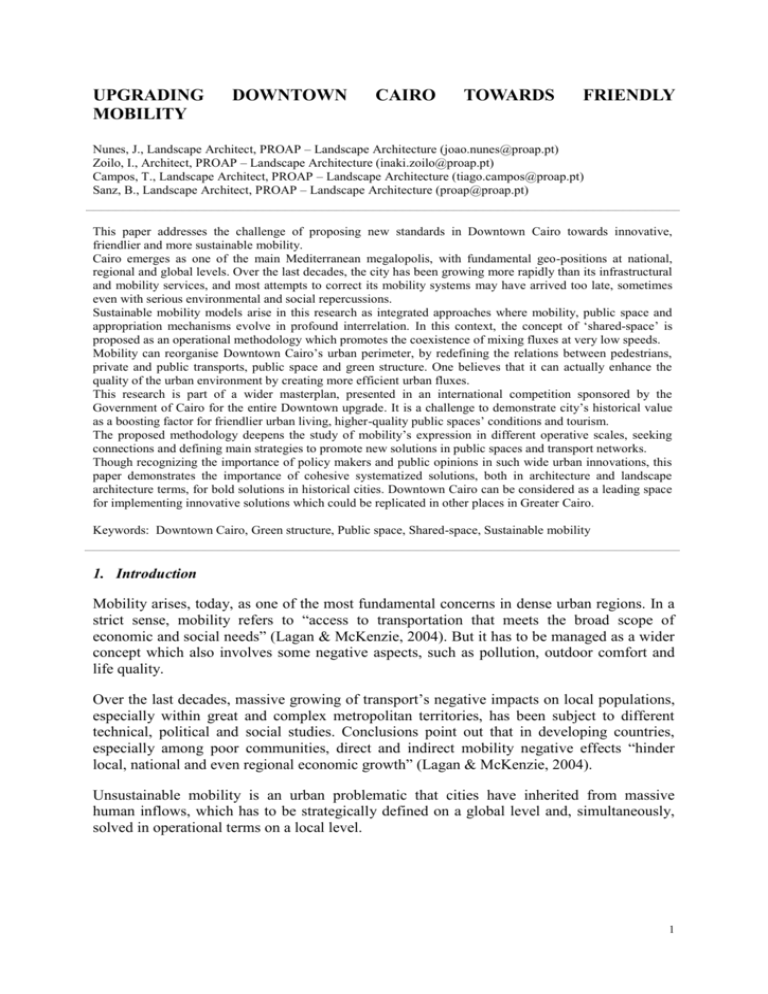
UPGRADING MOBILITY DOWNTOWN CAIRO TOWARDS FRIENDLY Nunes, J., Landscape Architect, PROAP – Landscape Architecture (joao.nunes@proap.pt) Zoilo, I., Architect, PROAP – Landscape Architecture (inaki.zoilo@proap.pt) Campos, T., Landscape Architect, PROAP – Landscape Architecture (tiago.campos@proap.pt) Sanz, B., Landscape Architect, PROAP – Landscape Architecture (proap@proap.pt) This paper addresses the challenge of proposing new standards in Downtown Cairo towards innovative, friendlier and more sustainable mobility. Cairo emerges as one of the main Mediterranean megalopolis, with fundamental geo-positions at national, regional and global levels. Over the last decades, the city has been growing more rapidly than its infrastructural and mobility services, and most attempts to correct its mobility systems may have arrived too late, sometimes even with serious environmental and social repercussions. Sustainable mobility models arise in this research as integrated approaches where mobility, public space and appropriation mechanisms evolve in profound interrelation. In this context, the concept of ‘shared-space’ is proposed as an operational methodology which promotes the coexistence of mixing fluxes at very low speeds. Mobility can reorganise Downtown Cairo’s urban perimeter, by redefining the relations between pedestrians, private and public transports, public space and green structure. One believes that it can actually enhance the quality of the urban environment by creating more efficient urban fluxes. This research is part of a wider masterplan, presented in an international competition sponsored by the Government of Cairo for the entire Downtown upgrade. It is a challenge to demonstrate city’s historical value as a boosting factor for friendlier urban living, higher-quality public spaces’ conditions and tourism. The proposed methodology deepens the study of mobility’s expression in different operative scales, seeking connections and defining main strategies to promote new solutions in public spaces and transport networks. Though recognizing the importance of policy makers and public opinions in such wide urban innovations, this paper demonstrates the importance of cohesive systematized solutions, both in architecture and landscape architecture terms, for bold solutions in historical cities. Downtown Cairo can be considered as a leading space for implementing innovative solutions which could be replicated in other places in Greater Cairo. Keywords: Downtown Cairo, Green structure, Public space, Shared-space, Sustainable mobility 1. Introduction Mobility arises, today, as one of the most fundamental concerns in dense urban regions. In a strict sense, mobility refers to “access to transportation that meets the broad scope of economic and social needs” (Lagan & McKenzie, 2004). But it has to be managed as a wider concept which also involves some negative aspects, such as pollution, outdoor comfort and life quality. Over the last decades, massive growing of transport’s negative impacts on local populations, especially within great and complex metropolitan territories, has been subject to different technical, political and social studies. Conclusions point out that in developing countries, especially among poor communities, direct and indirect mobility negative effects “hinder local, national and even regional economic growth” (Lagan & McKenzie, 2004). Unsustainable mobility is an urban problematic that cities have inherited from massive human inflows, which has to be strategically defined on a global level and, simultaneously, solved in operational terms on a local level. 1 This paper addresses the challenge of proposing new standards in Downtown Cairo towards innovative, friendlier and more sustainable mobility1. For millennia, Cairo has been one of the centres of the world. Being the largest city in the Arab world and even in Africa, its importance has been fundamental, as a tactical crossroads of all sorts of trading and social routes (Cook, 1984). However, and despite all political and infrastructural efforts to the contrary, it has been declining in terms of its efficiency and urban management to the point that, today, Cairo’s mobility is, indeed, a problem of great extent, particularly in historic centres, such as downtown (Figure 1). Figure 1. Aerial view of Cairo (Parque Expo 98, S.A., 2010). Cairo has been growing more rapidly than its infrastructural and mobility services. All the attempts to correct mobility systems, such as the metro network or road overpasses, may have arrived too late. Furthermore, some of these solutions have been having serious repercussions, not only to the environment (in the case of great infrastructures), but also to pedestrian circulations (in the case of increasing traffic lanes to the detriment of sidewalks) (Parque Expo 98, S.A., 2010). Up until now, the city has been unable to manage the implementation of an adequate network of public transport or to dissuade individual transport’s dense use or informal collective transport. 1 World Bank defines sustainable mobility by referring to the three pillars of: Economic and Financial Sustainability. “To be economically and financially sustainable, transport must be costeffective and continuously responsive to changing demands.” Social Sustainability. “Transport Strategies can be designed to provide the poor with better physical access to employment, education, and health services.” In addition, customer satisfaction is a key ingredient in creating a socially sustainable transport system. Environmental Sustainability. “Transport has significant effects on the environment that should be addressed explicitly in the design of programs. Making better use of readily available and cost-effective technology is necessary, but not in itself sufficient. More strategic action is also required in the form of better-directed planning of land use and stricter management of demand, including the use of pollution and congestion charges to correct the relative prices of private and public transport.” 2 Private vehicles (individual or collective), followed by their negative impacts on urban environment, arise as “one of the main concerns, if not the greatest, for the rehabilitation of Downtown Cairo” (Parque Expo 98, S.A., 2010). Sustainable mobility models are the ones which combine transportation networks, efficient in sustainability’s three main operational vectors – economic, social and environmental – without sacrificing human values within urban context. These models are considered one of the greatest challenges of the twenty-first century’s metropolises, not only because they are the support of cohesive and coherent urban development, but also because they are the main procedures to reduce important negative side effects on millions of people, such as air pollution, traffic congestion, noise, sprawl and public safety. This research had, as its starting point, a proposal for a wider masterplan – the Masterplan for Khedive, Cairo – presented during an international competition and sponsored by the Government of Cairo. The proposal had a theoretical basis, conceived by a multidisciplinary team of architects, landscape architects, engineers, managers and economists, and focused on the definition of important strategies concerning the city’s centre rehabilitation. It was not a winning proposal, but still, it induced important research methodologies towards creative and innovative solutions in terms of pedestrian mobility, traffic, green structure and public space (Figure 2). Figure 2. Aerial view of Downtown Cairo (Parque Expo 98, S.A., 2010). Upgrading Downtown Cairo towards friendly mobility is a contribution to the progressive development of a more humanised, cohesive and environmentally sustainable urban space, seeking to improve urban citizens’ quality of life and outdoor comfort conditions within this wide territory. 2. Current state of today’s Cairo mobility system Cairo, a city with millennia of history, has been validated as one of the world’s greatest urban centres. When considering the three Cairo Region Governorates, the total population in 2006 amounted to eighteen million people, but it is estimated that the northern Egypt territory has a growing population of close to fifty million inhabitants, occupying a surface similar to twice 3 the metropolitan region of New York and almost the triple of its population, which transforms into one the largest existing megalopolises. This ancient densely populated area can be explained by its excellent physical conditions and its continuous progress “as one of the densest and best ordered agrarian regions in the world”. Its natural evolution has turned Cairo into one of the main centres of a highly urbanized territory (Parque Expo 98, S.A., 2010). Cairo’s relatively rapid urbanization processes have triggered an equally fast demand for transportation. Statistics dating from the 1970’s decade stated that daily trips increased from five million to an exceeding eight million, a growing tendency that has been reported until the present decade (Cook, 1984). Over the last five decades there has been an explosive increase in the number of private vehicles registered in Greater Cairo, with a growing rate of approximately twenty per cent per annum. Even so, private car ownership is low, at around 26 per thousand inhabitants versus 300-450 per thousand in many European and North American cities. The development of the Central Business District (CBS), in the 1980’s, generated, by the end of the twentieth century, an estimated 600 person trips per hour per hectare, compared to 139 trips per hour per hectare in Central London. According to Cook (1984), the reason this number was so high in Cairo might be due to inadequate communication systems, but, even though, it is representative of changing mobility patterns, with growing demands within the city centre. Private vehicles are in the centre of this dramatic growth, enhancing the already problematic challenges in the provision of transportation within poor mobility networks. With some remarkable exceptions of certain high income suburbs, such as Heliopolis, Maadi and Dokki, Cairo’s road networks are extremely poor. In the 1980’s, reports such as the work done by (Cook, 1984), accounted that “foot-paths were frequently un-surfaced and blocked by materials and parked vehicles, forcing pedestrians into the streets”. What is even more extraordinary is that this situation, reported more than thirty years ago, has been testified until today. In some city sections, besides the almost non-existence of secondary roads, a great percentage of the areas are unpaved or have not an adequate surface road network (Parque Expo 98, S.A., 2010). A series of interrelated problems concerning public management and safety can be listed: waste removal, emergency vehicle access, uncontrolled flooding or even lack of security due to insufficient lighting systems. Further to these identified problems with physical expression, there are other situations, perhaps not so easy to measure, that confirm a cultural lack of respect and coexistence between drivers, pedestrians and authorities. As a result, Cairo is ranked among the countries with the highest traffic accidents in the world, more than twenty times when comparing to the levels of Europe or the USA. The conflicts between vehicles and pedestrians are increasingly dangerous by relatively long peak traffic jams, impeded traffic flows, inadequately developed secondary road networks and insufficiently effective traffic management and engineering systems. 4 The third group of problems is composed by pollution related issues. Greater Cairo alone accounts for fifty five per cent of the total Egyptian transport sector’s emissions. Although the total emission of CO2 per year is low on a global scale, authorities show a growing concern with the city centre’s air quality (Godard & Houpin, 2009) . But perhaps one of the most dramatic problems Cairo is registering today may be the progressive degradation of the urban environment, with the overwhelming presence of private vehicles invading almost all public spaces, which has been contributing to an actual decrease on the number of visitors. The secondary role given to pedestrians and collective transportation repudiates more tourists each year, which is translated into a real decrease in tourism incomes (Parque Expo 98, S.A., 2010). It is important, at this point, to refer the new metro network as one possibility to reduce mobility problems as well as environmental impacts. Even though it is small when compared to the total urban surface, according to Godard & Houpin (2009), in 2001, the metro network accounted for as little as four per cent of the energy consumed by Cairo, while already assuring seventeen per cent of the total daily transports. In such extremely dense megalopolises, metro networks appear as highly efficient modes of transportation, when comparing energy consumptions, CO2 emissions and the total amount of subsidies granted to both constructers and users. In order to reverse this paradigm, one has to acknowledge the serious consequences that the excessive presence of vehicles within the city have to the deterioration of environmental, social and even economic values of the territory. Pedestrians and collective transports must be seen as primordial elements towards a new friendlier and more sustainable mobility system. 3. A new mobility concept – the ‘Shared-space’ Mobility evolves, hand by hand, with urban planning and urban design. In large metropolises, such as Cairo, which have been under exponential urban growth during the last decades, this interrelation is quite clear 2. In the twentieth century, Cairo became a model city within the African continent, by being the first city to have a metro train network. As previously mentioned, it is a small network when compared to other metropolis, even though it has settled important urban transformations 3. Today, Cairo aims to be the first to evolve into new models of sustainable mobility. The proposal for the potential Master Plan for Khedive was presented as a challenge to rethink and upgrade Downtown Cairo by managing accessibility and mobility in a more sustainable way. The main conceptual goal was to articulate local mobility strategies directly 2 Sustainable mobility, as defined by the World Business Council for Sustainable Development, is the ability to meet society’s need to move freely, gain access, communicate, trade, and establish relationships without sacrificing other essential human or ecological values, today or in the future. 3 According to recent statistics, Cairo metro network is small (65,5 km) when compared to London metro network (402 km) and to New York metropolitan metro network (1.355 km) (NY MTA, 2010). 5 related to the city’s spatial planning with public space design and management (Parque Expo 98, S.A., 2010) 4. This plan’s approach sought the comprehension of mobility as a system and intermodal network, where all forms of transport coexist complementarily. Operational resolution models were presented for the main urban problems, in an attitude which acknowledges the inseparable relationship between mobility, pollution, quality of the public space and coherence of the urban green structure. Throughout this document, the following concepts will be explained: The efficiency and quality of the mobility networks by redefining the relations between pedestrians, private vehicles, public transport, public space and green structure; The relation between road traffic’s efficiency and the quality of the urban environment, with respect to air pollution and noise; The enhancement of public space’s quality, by optimizing microclimatic conditions in public spaces (humidity, temperature, radiation and breezes); The reinforcement of the green structure within the urban tissue, by enlarging tree densities in streets, squares and parks. This study for the future masterplan carried the notion of integrated approaches where mobility, public space and appropriation mechanisms evolve in profound interrelation. In central urban areas, people need to feel comfortable and safe while walking, cycling, or shopping in outdoor public spaces. In such areas “priority has to be people, space and then cars and not the other way around” (Alves, 2011). ‘Shared-space’ 5 is a well-tested solution which promotes the coexistence of mixing fluxes at very low speeds and in one same area. Several shared-space projects have already been tested in European and, more recently, North-American cities and are currently functioning with high degrees of efficiency (Alves, 2011). To implement shared-space related concepts to Downtown Cairo means, above all, a change in mentality. People in urban contexts need time to adapt to significant changes in their living environments. Therefore, this research and the project that supports it are also tools to promote different approaches phased in time, where policy, technical and even if technological decisions can be validated within innovative attitudes towards public spaces’ design processes. 4 Mobility plans are operational work tools for the implementation and management of cities’ mobility policies, which have to be developed simultaneously with all other sorts of urban management and development instruments. 5 Shared space is an emerging approach to urban design, traffic engineering and road safety, most commonly used in Europe and, increasingly, in North America. It was firstly used as an operative concept by the English author Ben Hamilton-Baillie, in 2003, as the research result of identifying a common thread in most urban areas on how to reduce the adverse impacts of traffic. “Shared space is the concept of integration”, with a clear distinction from the principle of segregation, (Hamilton-Baillie, 2006). Therefore, the idea of separation different functions and users in cities is confronted with the opportunity to develop a more inclusive and accessible urban environment within public spaces. 6 Some of the main strategies concerning pedestrian, public transport and roadway networks, as well as some parking policies were theoretically tested in some specific public spaces within the intervention area (Figure 3). 1 – El-Tharir Square and Cornich EL-Nil 2 – Ramses Street 3 – Ramses Square 4 – Attaba and Opera Squares and Azbakiyya Garden 5 – Abdeen Square Figure 3. The five intervention areas define an urban core in Downtown Cairo (Parque Expo 98, S.A., 2010). 3.1. Pedestrian Network The new concept for more effective appropriation of Downtown Cairo by pedestrian can only be achieved through a continuous and safe pedestrian network. The study settles exclusivity to pedestrian circulation in some important central routes. With this measure, the network is able to maximise pedestrian fluxes along the public space and facilitate the access to metro stations, Ramses rail station and collective public transport terminals (Figure 4). Structural pedestrian artery Pedestrian priority zone Street with dedicated pedestrian space Reference public space Figure 4. Pedestrian network (Parque Expo 98, S.A., 2010). 7 From the analysis of the image above, it is possible to identify some of the most important intervention projects, namely: Creating a structuring pedestrian artery, connecting El-Nil Square and Opera Square and, therefore, defining one main trunk of the pedestrian network which can become the nuclear generator of new urban ways of life. The artery will be consistent in pedestrian fluxes’ distribution across the urban fabric, reinforcing it within the existing road network; Creating and delimitating priority zones for pedestrian circulation, which constitute pedestrian network’s capillaries towards the structuring pedestrian artery. In these areas, road speed is limited to 30 km/h, and vehicles loose priority over pedestrians; Re-profiling the existing roadway network, by introducing more consistent spaces for pedestrians and facilitating pedestrian network’s continuities throughout the intervention area; Rehabilitating and reorganising public spaces that represent blockage points in the pedestrian network, especially squares identified as primary accesses to Downtown Cario. In this regards, the most significant interventions are located in Riyad Square, El-Tahrir Square, Ramsis Square and Attaba Square; Adapting public space for all user types, responding to a more inclusive mobility. Safety and comfort arise as important principles for pedestrian network’s design, especially when concerning people with reduced mobility. In order to minimise conflicts between the different users traffic-calming measures and pedestrian’s, protection may have to be implemented. 3.2. Public Transport Network Public transport network can be optimized by improving the existing infrastructures: creating new intermodal connections; enhancing accessibility; and amplifying existing services. Considering the new proposal for public transport it is estimated that practically the whole intervention area will be reached in less than ten minutes from metro stations and more than fifty per cent of the area will be reached in five minutes, with the new scenario of metro system. Main projects proposed by the plan are: Improvement of access, capacity, security and comfort of the metro system. The reasoning behind this purpose is that the metro network is able to partially absorb some of the road users that normally move through central roadway networks, such as private cars, taxis or buses. In this case, synchronization between public transport system and public space is quintessential, promoting adequate integration of access points to stations with pedestrian networks (Figure 5); Improvement of intermodal transport by creating an interface in Nasser metro station, which can connect different modes of transports and services. Creation and improvement of public transport stops, therefore increasing the capacity of public transport network to reduce conflicts with pedestrian circulation. In this regard, appropriate urban furniture and equipment, platforms shelters, signage, information points must be introduced as a complement. Installation of new bus corridors in order to improve conditions of bus circulations. 8 Metro stations Urban bus stops Bus regional network Ramses station Relevant road network Metro lines Nile boat terminal Figure 5. Public transport networks (Parque Expo 98, S.A., 2010) 3.3. Roadway Network Roadway network’s main strategies aim the reduction of vehicles entering and crossing Downtown Cairo daily up to 25-30% of cars (which translates into 10000 to 15000 cars per hour) during peak hours (Parque Expo 98, S.A., 2010). This reduction implies the reorganization of the circulation systems, in order to impede, or strongly diminish, through-travel carried out on streets with a desirable local character. If, on the one hand, traffic is concentrated along central road axis, with greater capacity to meet traffic levels, on the other hand, it is possible to reduce those levels in minor streets. The strict traffic management controls as well as crosses between roads with different hierarchy are necessary, in order to implement this new circulation system (Figure 6). Level 1 – Urban Expressway Level 2 – Urban Primary Arterial Street Level 3 – Urban Secondary Arterial Street Level 4 – Collector /Distributor Street Figure 6. Hierarchy of Road Network (Parque Expo 98, S.A., 2010). 9 When concerning the roadway network system, two main intervention projects are carefully mentioned in the present proposal (Table 1 and Figure 7): Reorganization and re-profile of the roadway network, considering a new roadway hierarchy, which differentiates local, urban and sub-urban traffic. The roadway hierarchy defined for the intervention area seeks to channel most significant traffic flows into specific corridors, in order to free up area for pedestrian paths; Introduction of traffic management and control measures, ensuring the reduction in number of vehicles entering in the pedestrian arteries or priority zones for pedestrians. A centralized traffic-control system based on the installation of traffic lights at the principal junctions is able to record the number of vehicles and adjust the existing traffic levels to the capacity of each junction, avoiding the creation of traffic congestion. Complementary to this, traffic lights optimize internal Downtown’s circulation and protect pedestrian crossings. Table 1. Future road network conditions Functional classification Max. capacity (hour/lane) Number of lanes per way Urban expressway 1.500 vehicles 3 or more Urban primary arterial street 1.000 vehicles Max 3 Urban secondary arterial street 700 vehicles Max 3 Collector /Distributor street 500 vehicles Max 2 Local street 300 vehicles Max 2 Traffic volume (vehicles/peak hour) 0-600 600-1200 1200-1400 2400-3600 More 3600 Figure 7. Future traffic conditions (Parque Expo 98, S.A., 2010) . 10 3.4. Parking policy The mobility plan within our proposal also examines parking on public streets. It puts forward the implementation of fee-paying parking to certain arteries within the intervention area. A careful analysis of parking demand demonstrates the need to identify areas with a clear lack of parking and to draw up an action plan to meet existing needs. Although in a conceptual level, the main parking policies were taken accordingly to the urban densities of the different homogeneous urban fabrics. Guarantying fee-paying parking on public streets essentially meets the demand by visitors for temporary parking. In addition, connections between the pedestrian network and parking areas are also analysed in terms of pedestrian’s accessibility and safety (Table 2 and Figure 8). Table 2. Parking policy Zone / level Parking Share of streets Prohibited 8.00AM to 8.00PM 50% Parking with fee 50% Prohibited 8.00AM to 8.00PM 30% Parking with fee 70% Prohibited 8.00AM to 8.00PM 20% Parking with fee 80% A B C Level A (high urban density) Level B (high to medium urban density) Level C (medium urban density) Out of A, B, C Figure 8. Parking policy (Parque Expo 98, S.A., 2010). 11 4. Green structure 4.1. Vision and main strategies The present document strongly defends the consolidation of the green structure in close relation with the development of the public space. Once again, the main goal is to redefine the urban relation between pedestrian and roadway networks. The concept of “landscape oasis” 6 is pointed out as an opportunity to establish an interconnected, but not necessarily continuous, green framework, as gaps between spaces of different types and scales, as well as private and public characters, are respected. Furthermore, the green structure is understood as a realistic possibility to optimise the set of conditions which enhances micro-climatic comfort in outdoor spaces and decreases traffic noises’ levels. Vegetation plays a key role within urban perimeters due to its ability to: Promote shaded areas; Manipulate, positively, temperature/humidity ratio; Enhance wind breezes; Support consistent protection and framing buffers (Nunes, Marques, Campos, & Coutinho, 2011). It is expected that this concept for the green structure improves public space’s quality, guarantying a friendlier and more sustainable city centre. A green urban system that works both as a collection of urban experiences for citizens of Cairo and as a network made of ecological corridors with important environmental value for the El-Nil River itself and Downtown Cairo. The proposal proposes to reorganize, redesign, increase and reconnect green urban spaces at various levels: from big parks and gardens to small squares and tree-lined streets. The aim is to recover spatial connections between the distinct green subunits, by imprinting on them a more human scale when facing, and solving, most problems caused by traffic circulation systems. As previously mentioned, shared-space 7 appears as a nuclear approach in green structure as well. In fact, the plan proposes a dilution of the classical models of road design, where pedestrians and vehicles are strongly segregated. On the contrary, the presented masterplan seeks the creation of a system of public spaces consistently designed also through the green structure and with integrated approaches, where pedestrian areas acquire a central position towards road lanes. A system independent from the traditional codes of road design. 6 The urban life in Cairo is concentrated around the margins of the El-Nil River. For its peculiar scale within the urban fabric, the river emerges as an urban “landscape oasis”, especially in Downtown area, due to the effect of both riversides towards a more comfort microclimate (Parque Expo 98, S.A., 2010). 7 Shared space, in its most inclusive conception, integrates fundamental green structure principles as premises for an integrated design of public space. Green structure improves micro-climatic conditions, favoring or improving more intense pedestrian appropriations, therefore, allowing a more consistent coexistence between all sorts of users (Alves, 2011). 12 The different scales of the proposed green structure establish a continuous pulse between the great urban spaces and the household outer space. And, in strategic terms, the plan reveals an even stronger drive, as it accounts with the detected great urban voids in the peripheral limits as additional opportunities to incorporate them into the green system, enlarging and reinforcing the structure from the centre towards suburbia (Figure 9). 01 – Al-Azhar Park 02 – Maldan Salad Ad-Din 03 – Al-Fostat 04 – Governmental Park 05 – Garden City 06 – Gazira 07 – Ramses Square 08 – Ataba and Opera Squares 09 – Abdeen Square 10 – Tahrir Square and Nile 11 – Six of October and Ryad Figure 9. Strategic green structure (Parque Expo 98, S.A., 2010). The green structure was proposed in an intimate relation to the mobility network, complementing and reinforcing it. The proposal defined the following composition: Structural green spaces on a local scale (Figure 10): Large recreational green areas with historical and cultural values or spaces with iconic and representative character, such as the El-Nil River riverfront; Spaces interconnected through a local network of soft mobility and tree-line arteries, forming continuous links within the urban fabric; Green areas developed around the structural arteries for pedestrian circulation within Downtown Cairo, such as: Ramsis, Khullud, El-Sheikh Rihan, Qsar ElNil, El-Gummhuriya; Structural green corridors on a strategic scale (Figure 11): Corridors that assure green structure’s continuity at the metropolitan level; Linear structures that incorporate consolidated of foreseen public and private areas; 13 Tree-lined arteries along both pedestrian and traffic networks that ensure the continuity of the ecological infrastructure. Figure 10. Conceptual project for Opera Square with the reinforcement of the planting areas (Parque Expo 98, S.A., 2010). Figure 11. One of Downtown’s most important arteries, transformed accordingly to shared-spaces principles (Parque Expo 98, S.A., 2010). The two types of structural elements above mentioned ensure the continuity of the green structure, not only on a local scale, but at the metropolitan level as well. Furthermore, they actively contribute to the urban reorganization of public spaces, enhancing their environmental quality. On a strategic level, the green corridors are important complements to the main networks of soft mobility that interconnect different Downtown areas. 4.2. The influence of the green structure on outdoor microclimatic conditions Recent development plans of large urban areas in great metropolises brought a growing concert to promote bioclimatic comfort in outdoor public spaces. When carefully studied and implemented, an urban green structure can positively manipulate outdoor microclimatic conditions, therefore enhancing comfort-related parameters. The conceptual idea behind this relation is the manipulation of natural climatic characteristics, adapting them to “the ideal conditions of temperature, humidity, solar radiation, and wind protection” (Nunes, et al., 2011). When achieving thermally comfortable outdoor spaces so that they can be used throughout the year, and with special concern to hot summers such as Cairo’s, energy uses and associated carbon emissions are strongly reduced. If a holistic sustainability’s definition is taken into account, this reasoning becomes relevant not only because it promotes the continued use of space, but also because it minimizes system’s balance of inputs and outputs (Nunes, Marques, Campos, & Coutinho, Modular landscapes in arid climates, 2011) Microclimate regulation with shade, vegetation or wind breezes is achieved through the manipulation of the ratio between temperature and humidity: Combination between both natural and artificial shades decreases air temperature decrease by limiting direct and indirect radiation. Furthermore it enhances air 14 circulations and thermal exchange (Nunes, Marques, Campos, & Coutinho, Modular landscapes in arid climates, 2011); Use of plants, recognizing its strong result on microclimate control, effectively reducing energy for cooling purposed through evapotranspiration. Furthermore, vegetation provides solar protection by shading (Panagopoulos, 2008); Reinforcement of wind speed and direction through the succession of open and enclosed areas, generating local wind breezes which can provide microclimatic comfort. The presence of outdoor shading structures can generate important air renovation and produce spatial gradients between air and paved surfaces’ temperature throughout day and night (Nunes, Marques, Campos, & Coutinho, Modular landscapes in arid climates, 2011). This research focused on some of these passive tecnhiques as means of achieving higher standards of outdoor comfort in public space. In some intervention areas, such as the proposal for Opera Square, vegetation reinforcement was a primordial strategy for more effective appropriations patterns (Figure 12). Other important strategy in this project may be the use of artificial shade for positive handling of this square’s microclimatic conditions (Figure 13). Figure 12. Conceptual image for one Opera Square’s main pathway (Parque Expo 98, S.A., 2010). Figure 13. Conceptual image for shaded areas in Opera Square (Parque Expo 98, S.A., 2010). Vegetation and artificial shades play key roles in the positive manipulation of microclimatic conditions. 5. Conclusions and considerations. Human car free city The proposed mobility system within this research, in profound accordance to Khedive’s masterplan’s main procedures, seeks to meet people’s needs and desires concerning accessibility, commerce, recreation, cultural facilities and residences, by using minimum resources. Mobility is seen as an operational approach within Downtown Cairo’s urban perimeter, which redefines conceptual and physical relations between pedestrians, private and public transports, public space and green structure. It is reasoning with the explicit drive of demonstrating that the higher the efficiency on people’s urban fluxes, the higher the quality of the urban environment. This demonstration is explained in close relation with quantitative measure parameters, such as air pollution, noise, or microclimatic conditions. Upgrading Downtown Cairo towards more sustainable and efficient forms of urban living involves strong processes of creating consolidated areas for the pedestrian fluxes, of controlling access to certain road arteries in an attempt to facilitate circulation, of 15 implementing parking rules and restricted areas where public transport prevails. Furthermore, it is recognized the importance of complementary measures that go beyond the scope of this investigation, namely: projects and other proposals for urban concentration around central collective transport systems’ hubs, especially in stations with heavy fluxes; or even measures which reinforce re-urbanisation processes in existing quarters, redefining concepts of neighbourhood (Figure 14). Figure 14. New Boulevard towards Cairo’s Museum, where pedestrians acquire a leading role (Parque Expo 98, S.A., 2010). This proposal is a challenge to achieve a friendlier and, as much as possible, car-free Downtown Cairo. This experiment brings the importance of organising vehicle transit routes so that pedestrian fluxes acquire a central urban role in terms of area, continuity and connectivity. With these public spaces’ redefinitions, one believes that it will be possible to walk along city’s main arteries from any point in city centre to the river with unrestricted, rational and, at the same time, increasingly stimulating movements (Figures 15 and 16). Figure 15. Conceptual image for the new marina area near the museum (Parque Expo 98, S.A., 2010). Figure 16. Conceptual image for the redesigned Abdeen Square (Parque Expo 98, S.A., 2010). Green structure is pointed out as a design strategy to reinforce the urban tissue. Once again, this system has an important potential role in redefining fluxes’ relations within very dense urban centres. Its strategic importance is strengthened by the conscience of its active role in microclimatic conditions manipulation. The higher the standards in outdoor public spaces, the more effective become potential appropriation from distinct users. 16 Public space and mobility networks can be integrated and consolidated at the expense of a cohesive green structure, which emerges as a complement to new mobility models, such as shared-space. The proposed green structure takes advantage of existing large green spaces – strong symbolic and historic public areas –and green corridors – main urban arteries – and acquires an essential strategic value by promoting connections with EL-Nil River banksides, as well as, with other potential spaces in Cairo’s suburban areas. A rehabilitation process such as the one proposed for the potential Khedive’s masterplan for Downtown Cairo is a complex, perhaps quite slow, evolutional mechanism. Supporting all urban measures and action plans with spatial expression lays a mentality change that is based on the collective will to improve citizens’ urban conditions. This document presents an example of how innovative urban, architecture and landscapearchitecture solutions can positively interfere on existing mobility networks. It should be understood as a theoretical case-study, with strong and realistic design approaches, that can eventually be expanded to other areas of Greater Cairo for further improvement of social, economic and environmental standards and dynamics of this growing metropolis. 6. References Alves, M. (2011). Mobility - Shared-Space (oral communication). Portugal. Aronson, S. (2008). Aridscapes-Designing in harsh and fragile lands. Barcelona: Gustavo Gili,SL. Cook, D. (1984). Transport Problems in Cairo. In The Expanding Metropolis coping with the urban growth of Cairo (p. 152 a 157). Egypt: The Aga Khan Award for Architecture. Godard, X., & Houpin, S. (2009). Report of the Workshop on "Greater Cairo Case Study on trends and prospects of urban mobility". France: Blue Plan Regional Activity Center. Hamilton-Baillie, B. (2006, August). What is Shared-Space? Retrieved October 10, 2011, from Hamilton-Baillie Associates: http://www.hamiltonbaillie.co.uk/_files/_publications/6-1.pdf Lagan, C., & McKenzie, J. (2004). Sustainable Cities, Sustainable Transportation. Retrieved September 23, 2011, from Eart Trends. The environmental information portal: http://earthtrends.wri.org/features/view_feature.php?fid=54&theme=4 Lagan, C., & McKenzie, J. (2004). Sustainable Cities, Sustainable Transportation. Retrieved 09 23, 2011, from Eart Trends. The environmental information portal: http://earthtrends.wri.org/features/view_feature.php?fid=54&theme=4 Nunes, J., Marques, A., Campos, T., & Coutinho, R. (2011). Modular landscapes in arid climates. In L. A. PROAP (Ed.), EFLA 2011 Anual Congress (p. 14). Estonia: EFLA. Nunes, J., Marques, A., Campos, T., & Coutinho, R. (2011). Modular landscapes in arid climates. EFLA 2011 Anual Congress (p. 17). Estonia: EFLA. Nunes, J., Zoilo, I., Jacinto, N., Nunes, A., Campos, T., Pacheco, M., et al. (2011). Mistingcooling systems for microclimatic control in public space. EFLA 2011 Anual Congress (p. 16). Estonia: EFLA. 17 NY MTA. (2010). Subway and bus ridership. Retrieved September 28, 2011, from MTA.info: http://mta.info/nyct/facts/ridership/index.htm Panagopoulos, T. (2008). Using microclimatic landscape design to create thermal comfort and energy efficiency. Actas da 1ª Conferência sobre Edifícios Eficientes (pp. 1-4). Faro: University of Algarve. Parque Expo 98, S.A. (2010). Masterplan for the revitalization and upgrading of the central zone of Khedive's Cairo. Portugal: Parque Expo 98, S.A. 7. Main authors’ biographies JOÃO NUNES Lisbon,1960 Founder and CEO of the Landscape Architecture Studio PROAP, which gathers a vast group of professionals in a cross-disciplinary team, with distinguished levels of expertise in landscape, in its most inclusive conception. As International Director is responsible for the strategic, executive and tactical leadership of the three international offices: Lisbon (Portugal), Luanda (Angola) and Treviso (Italy). Develops PROAP’s conceptual and creative design and defines the strategic orientation of the research processes. Has been lecturing at the Instituto Superior de Agronomia in Lisbon (Agronomics Institute, Technical University of Lisbon) since 1991. Currently also lectures at the Istituto Universitario de Architettura de Venezia, Politecnico de Milano, Politécnico di Torino, Roma La Sapienza, Roma Ludovico Quaroni, Facoltá di Architettura di Alghero. IÑAKI ZOILO Zaldibia, 1972 Partner at the Landscape Architecture Studio PROAP, which gathers a vast group of landscape architects, architects, designers and plastic artists, part of a core oriented by João Nunes. Involved in PROAP’s strategic direction and management, oversees research and design projects to assure conceptual and artistic coherence. As senior overall project manager is responsible for the coordination and implementation of all projects. Leads the organisation and the development of the design competition teams in their conceptual and technical execution. Frequently participates as guest lecturer in international design and art workshops, representing PROAP. TIAGO TORRES CAMPOS 18 Lisbon, 1982 Research Manager at the Landscape Architecture Studio PROAP, which gathers a vast group of landscape architects, architects, designers and plastic artists, part of a core oriented by João Nunes. Managing Editor for PROAP’s publications. Jointly runs the international communication processes, manages graphic and written project information sent to media requests worldwide. Participates tactically in the creative processes, review and critique of projects. Frequently participates in international workshops and conferences, representing PROAP. BERTA SANZ PEÑA Madrid, 1980 Landscape Architect /Researcher at Landscape Architecture Studio PROAP, which gathers a vast group of landscape architects, architects, designers and plastic artists, part of a core oriented by João Nunes. Degree in Landscape Architecture at Wageningen University and in Agricultural Engineering at Escuela Técnica Superior de Ingenieros Agrónomos – Universidad Politécnica de Madrid. PhD candidate at the same university. Participates in several international project designs, research processes and paper writings for publications and conferences. 19

